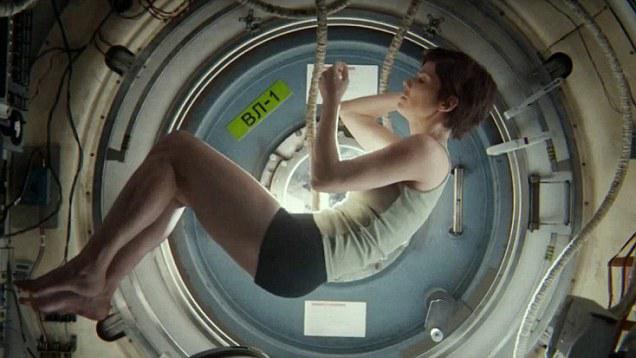Almost everybody has gone all weightless over Gravity. I have, too. I saw Alfonso Cuarón’s survival-in-space thriller Saturday afternoon at the Uptown Cinema in Washington, D.C.—the same grand, old-timey single-screen theater where Stanley Kubrick’s 2001: A Space Odyssey had its world premiere 45 years ago—and it completely lived up to the rapturous reviews I’d been reading since it debuted on the festival circuit several weeks ago. Brilliantly designed, breathtakingly photographed, sensitively performed, and ruthlessly paced, Gravity, purely as a cinematic pulse-quickener, approaches perfection.
But only approaches perfection. The flaw that puts the “near” in “near-perfect” is that—and this might qualify as a mild spoiler—the screenplay, by director Cuarón and his son Jonas, supplies its heroine, novice astronaut Ryan Stone (Sandra Bullock), with a backstory. She confides in senior astronaut Matt Kowalski (George Clooney) that she had a daughter who died in a freak playground accident. This disclosure arrives as if to justify Dr. Stone’s pessimism about their chances, after their space shuttle is destroyed by an angry swarm of satellite parts boomeranging around Earth at the speed of a bullet.
Why, you might ask, does she need an emotional handicap to believe she’s going to die in a situation where she is, in fact, incredibly likely to die? Good question! She’s stranded 250 miles above Earth’s surface, in a space suit that’s quickly running out of air, and also getting shot at, in essence, by orbiting debris. Surely that’s enough drama to sustain our interest, especially in a film that runs only 91 minutes and unfolds not quite in real time, but in something close to it. The backstory adds a dollop of schmaltz to a dish that is otherwise delicious.
And Cuarón could have learned as much from one of the many movies that must have been on his mind as he made his new one: James Cameron’s Aliens. (Cameron, by the way, says Gravity is “the best space movie ever done.”) Like Gravity, Aliens is the story of a space-faring woman—Warrant Officer Ellen Ripley, a character made iconic by Sigourney Weaver in Alien and its three direct sequels—who must survive a terrifying and deadly set of circumstances through sheer resourcefulness and force of will. And Ripley has the same backstory as Gravity’s Dr. Stone: She lost a daughter.
Aliens opens with Ripley’s escape pod drifting in space. After she’s rescued and revived, she receives the shocking news that 57 years have passed since the events of Alien. While she was hibernating in her lifeboat, the little girl she left behind on Earth—whom she never mentioned in Alien, which, OK, is a little weird, given the frequency with which people bring up their kids even when not facing death at the spiky hands of dual-jawed, acid-blooded beasts, but whatever—came of age, lived her life, and died at the age of 66. This is obviously intended to give additional emotional oomph to what becomes Aliens’ key relationship: the maternal bond between Ripley and Newt, the traumatized little girl who, like Ripley herself, is the lone survivor of an alien attack.
Now, there’s a chance you don’t remember all that, even if you’ve seen the movie recently. Because that stuff about Ripley’s daughter? It’s not in the theatrical cut of Aliens released in the summer of 1986.
Blockbuster popcorn flicks now approach the three-hour mark with butt-numbing frequency, but a generation ago, 20th Century Fox executives saw Aliens’s 2.5-hour running time as a problem. Cameron cut the film to the more palatable (though still long for the genre and era) 137 minutes. Losing Ripley’s daughter shaved about three minutes. The scene was restored for extended home-video editions years later, and is currently available on the Alien Anthology Blu-ray set—which, like Kind of Blue andThe Complete Works of William Shakespeare, is a document every civilized person should own. (Fun trivia: The photograph of Ripley’s deceased adult daughter that she cries over is actually a picture of Weaver’s mom, who was alive and well at the time.)
After the film came out, Weaver was not shy about telling interviewers how displeased she was that Cameron had cut this scene: She’d calibrated her whole performance around it, she said. Presumably she was consoled the following winter, when Aliens netted her an Academy Award nomination for Best Actress—in a time when acting nominations for genre films were even more rare than they are now.
As that nomination suggests, Cameron’s instinct to pull back proved to be right: Weaver might’ve needed that scene, but the audience did not. Ripley’s de facto adoption of Newt, sold through Weaver’s expertly layered performance, was dramatic enough as an event that emerged in the “present” of the narrative. We didn’t need to know she’d had a daughter of her own to buy into it.
Gravity had me thinking about this scene again, because it illustrates how attitudes about what movies need have changed in the 27 years since Aliens. Terse and capable, Ripley is a holdover from an era when characters in popcorn flicks did not require obvious handholds of “relatability.” It was enough for them to seem like real people, likeable or not.
Cuarón is a virtuoso filmmaker by any measure. 2006’s Children of Men alone would be enough to place him in the first rank of science-fiction directors. That movie, as it happens, also features a dead-child backstory—but there it makes far more sense, as the whole movie is about dead children. And the dead child in question wasn’t killed in a freakish playground incident, but in a flu epidemic that ravaged Children of Men’s alternate-universe Earth in 2008.
In Gravity, on the other hand, the lily-gilding dead-kid backstory feels off, like a studio note, or a star’s demand. It’s the one aspect of an otherwise brilliantly executed film that doesn’t feel weightless. Bullock’s tears may float in front of us in 3D, but in space, no one can hear you cry.
